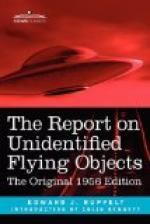This time one of the tower operators picked up a microphone, called the pilot of a C-54 that was crossing Tokyo Bay, and asked if he could see the light. The pilot didn’t see anything unusual.
At 11:45P.M., according to the logbook in the tower, one of the operators called a nearby radar site and asked if they had an unidentified target on their scopes. They did.
The FEAF intelligence officers who investigated the sighting made a special effort to try to find out if the radar’s unidentified target and the light were the same object. They deduced that they were since, when the tower operators and the radar operators compared notes over the telephone, the light and the radar target were in the same location and were moving in the same direction.
For about five minutes the radar tracked the UFO as it cut back and forth across the central part of Tokyo Bay, sometimes traveling so slowly that it almost hovered and then speeding up to 300 miles an hour. All of this time the tower operators were watching the light through binoculars. Several times when the UFO approached the radar station—once it came within 10 miles—a radar operator went outside to find out if he could see the light but no one at the radar site ever saw it. Back at the air base the tower operators had called other people and they saw the light. Later on the tower man said that he had the distinct feeling that the light was highly directional, like a spotlight.
Some of the people who were watching thought that the UFO might be a lighted balloon; so, for the sake of comparison, a lighted weather balloon was released. But the light on the balloon was much more “yellowish” than the UFO and in a matter of seconds it had traveled far enough away that the light was no longer visible. This gave the observers a chance to compare the size of the balloon and the size of the dark, shadowy part of the UFO. Had the UFO been 10 miles away it would have been 50 feet in diameter.
Three minutes after midnight an F-94 scrambled from nearby Johnson AFB came into the area. The ground controller sent the F-94 south of Yokohama, up Tokyo Bay, and brought him in “behind” the UFO. The second that the ground controller had the F-94 pilot lined up and told him that he was in line for a radar run, the radar operator in the rear seat of the F-94 called out that he had a lock-on. His target was at 6,000 yards, 10 degrees to the right and 10 degrees below the F-94. The lock-on was held for ninety seconds as the ground controller watched both the UFO and the F-94 make a turn and come toward the ground radar site. Just as the target entered the “ground clutter”—the permanent and solid target near the radar station caused by the radar beam’s striking the ground—the lock-on was broken. The target seemed to pull away swiftly from the jet interceptor. At almost this exact instant the tower operators reported that they had lost visual contact with the UFO. The tower called the F-94 and asked if they had seen anything visually during the chase—they hadn’t. The F-94 crew stayed in the area ten or fifteen more minutes but couldn’t see anything or pick up any more targets on their radar.




